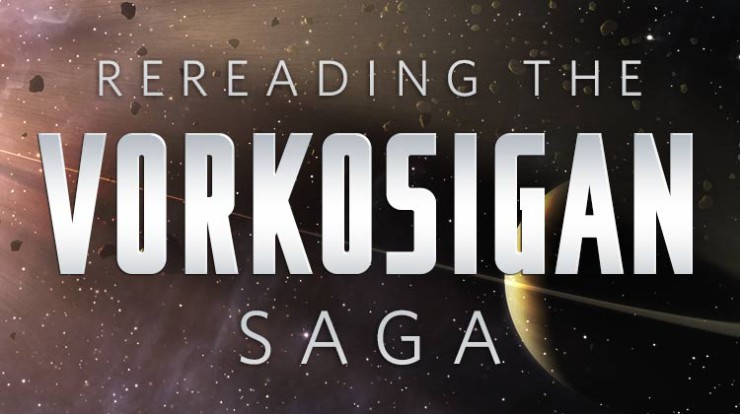This week, the reread jumps roughly 15 years from Barrayar to The Warrior’s Apprentice. First published in 1986, this is the first book in the series to feature Miles Vorkosigan, the fourth in reading order, and the second in publication order. At the time of publication, the only other book in the series was Shards of Honor, published two months earlier. I’m retroactively jealous of 1986 for getting two Vorkosigan books as beach reads, though I think that going straight from Shards to Miles’s adolescence must have caused readers whiplash.
If you’d like to catch up on previous posts in the reread, the index is here, and a series of blog posts on The Warrior’s Apprentice by Jo Walton can be found by following the Warrior’s Apprentice tag. At this time, the spoiler policy permits discussion of all books EXCEPT Gentlemen Jole and the Red Queen. Discussion of any and all revelations from or about that book should be whited out.
The Warrior’s Apprentice was the first of the Vorkosigan Saga books I read. I’m not completely certain of the exact provenance of my first copy, now tragically lost in the sands of having moved across the country twice, but I believe it was a gift from my father, and that’s the story I’m sticking with. I am completely certain of the cover that book had on it. It was this amazing piece by Alan Gutierrez, redolent with the sweet promise of a rollicking adventure:
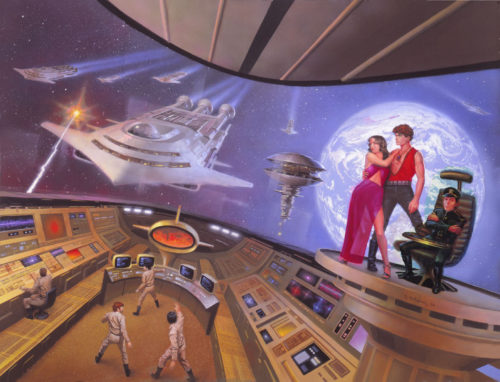
The right hand side features Miles in the command chair, probably about to say something cutting (“God help us”). From the way Elena Bothari is clutching him, I deduce that the muscular person in the tank top is Baz Jesek. This is completely inaccurate. Elena Bothari is a young woman in unique and complicated circumstances, wrestling with the truth about her home planet, her parents, and herself. She would never stand on the bridge of a ship and clutch Baz. Other places maybe, but not the bridge. I regret Elena’s exploitation.
Baz clashes with his date, but the intersection between the downwards V that reveals his abs and the upward V that reveals hers is an eye-catching apology for the color of his shirt. Ms. Bothari has chosen a stunning pink evening gown for this occasion. I applaud Elena’s use of the thigh slit to accentuate the length and shapeliness of her leg, while her gaze accentuates the emergency that is taking place in the left half of the image, under the back cover copy. It has some guy characters, there is a girl character, there’s going to be space-fighting—there are many reasons to pick up this book, and these are a necessary and sufficient subset of them. In the art collection of my dreams, this hangs right next to the Boris Vallejo painting of Spock’s shirtless psychic son riding a unicorn through the Guardian of Forever.
This is a hard act to follow, and many have struggled. The Fictionwise ebook cover below seems to draw its inspiration from an imagined nexus of Tron and The Sound of Music, with a sort of hopeful suggestion of space provided by Saturn’s rings in the background.
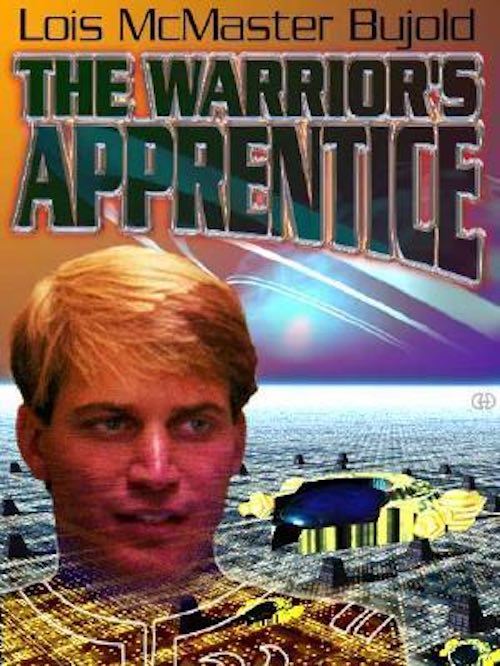
Miles’s hair has turned blonde here, I assume because that’s what was readily available in clip art.
A character gazing upward against a vaguely space-ish backdrop is a great way to imply a science fictional story without saying anything at all. So is the logo of a prominent SF publisher on the cover—the illustration isn’t really adding anything. If you omitted the title, this could just as easily be the cover of almost any SF novel with a white male protagonist.
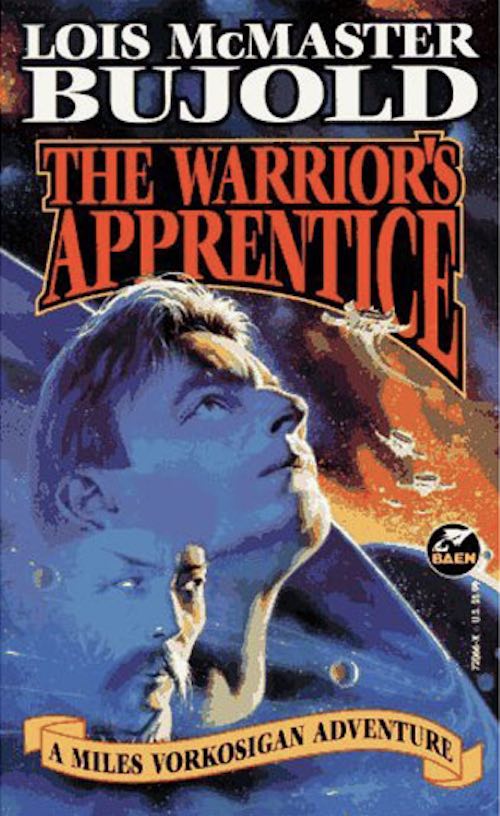
I feel compelled to point out the awkward intersection of Miles’s ear with the forehead of the guy with the mustache, who could be either Bothari or Tung. Miles looks kind of like a Back to the Future era Michael J. Fox.
And below, he looks like Luke Skywalker. When does this even happen? Nothing like this is in the book.
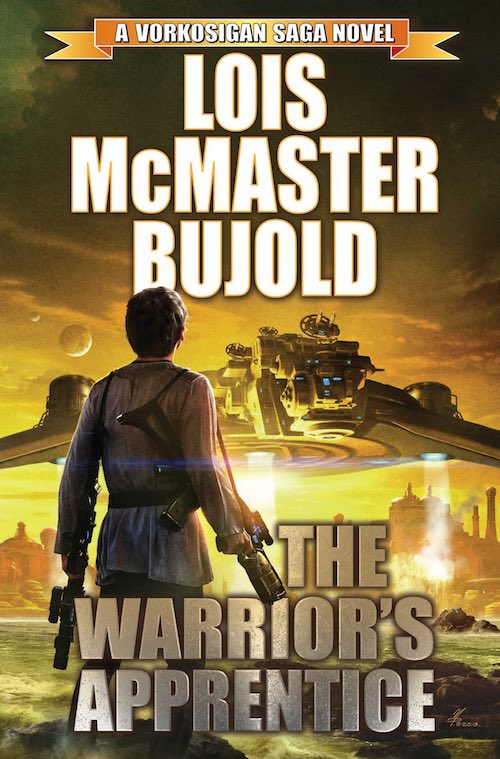
Both are better than this option, which sticks entirely with space ships that, through their shape and color, evoke feces and phalluses:
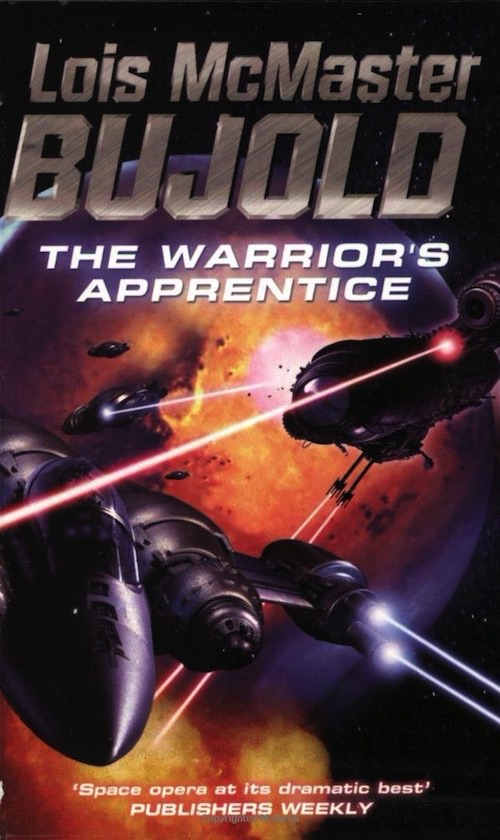
Who is the warrior? Who is the apprentice? Who cares! I appreciate a good space fight, but the lack of character development here is dismaying.
Usually, we run inside the hamster wheel. I can’t tell who’s running or what the circle represents. I have been enjoying the Zen-like abstract minimalism of many of these Amazon e-book covers. Not this one.
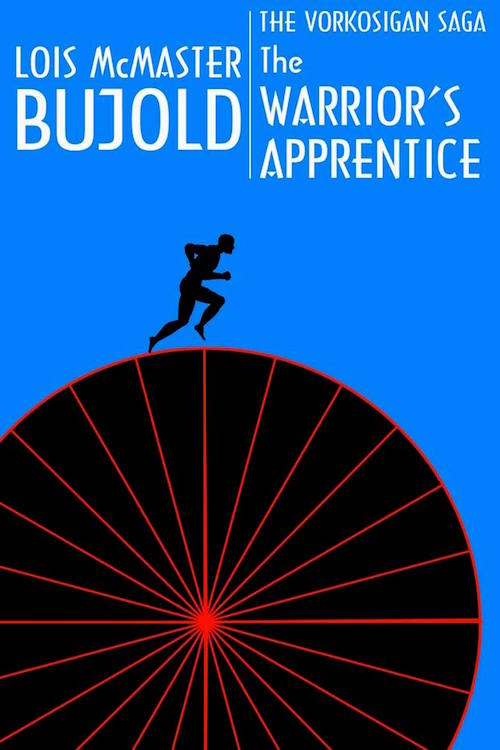
The NESFA Press cover brings the characters back into the equation. The characters’ facial features here are oddly unemotional and flat. I’m not sure whether the man on the left, looking disinterested while holding a fuel line for no apparent reason, is Bothari or Baz. The man on the right could be General Tung. The faint orange tinge makes his uniform and beret read more as “aging jockey” than “mercenary commander.” Miles looks unusually effeminate for a character who is described as having a five o’clock shadow. I know that’s space armor, but that doesn’t keep me from thinking that Miles is climbing out of the carcass of a giant earthworm.
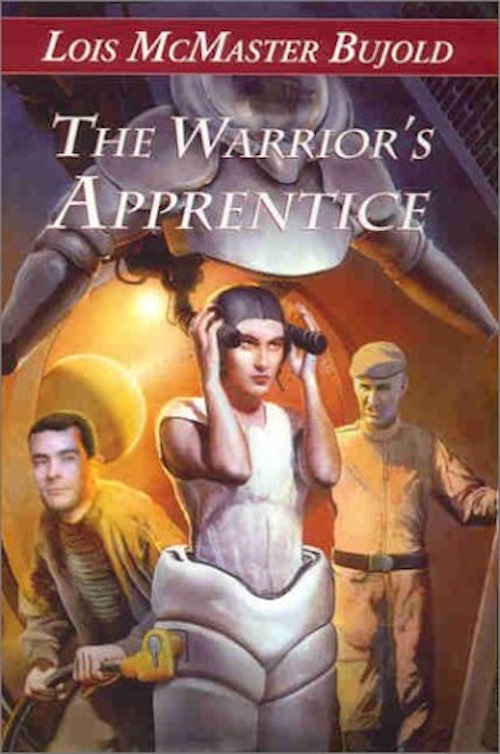
I like Alan Gutierrez’s work on this cover too much to give anyone else the time of day.
SUMMARY
Chapter one of The Warrior’s Apprentice begins with Miles’s fondest ambition. He wants to go to the Imperial Military Academy, to learn space-fighting. He’s completed the paper-and-pencil tests already—today is physical fitness. He offers a brief explanation of his medical history for his running partner, helpfully explaining that his lifetime of treatment is “why I can walk around today, instead of being carried in a bucket.” He has petitioned to have his scores averaged, instead of taken separately, to make up for his likely dismal performance on the obstacle course. Miles’s dream dies when he breaks his legs at the first obstacle, a five-meter wall with spikes on top. He returns home to break the bad news to his grandfather.
COMMENTARY
I could make an argument for the persistence of traditional infantry in the Barrayaran military, but I won’t, because Bujold doesn’t. The education Miles is seeking here is “training in the tactics of energy weapons, wormhole exits, and planetary defense”—it’s space stuff. We’ve seen a few space commanders in the series history. Aral Vorkosigan was stunned by his mutinous crew while attempting to apprehend a Betan Survey party and had to hike across 200 km of wilderness to take back his command from the mutineers. But Admiral Kanzian was “overweight and undertall,” and Jolly Nolly had colitis. The physical fitness requirements seem flexible.
The admissions requirements for the Barrayar’s elite space-fighting school include climbing a 5-meter wall, crawling under laser fire, and running both a short (5km) and a long (100 km) distance.
For this week’s blog post, I’ve invented a game I call “Do you get a lot of call for that in space-fighting?”
Round 1—climbing a 5 meter wall with spikes on top—NO
Round 2—jumping off a 5 meter wall—NO. Dude, you got to the place with the wall in a spaceship, have it put you down on your preferred side of the wall.
Round 3—crawling under laser fire—MAYBE, sometimes. I mean, it seems like a thing that could happen. I think crawling under the laser fire would probably not be the best way to handle it in most circumstances, but I imagine that sometimes you need at least one guy to do that for some reason, like to disarm the weapons system. It sounds pretty far-fetched to me, but I’ll let it pass.
Round 4—running 5K—YES—Starbuck was always jogging on Battlestar Galactica. Cardio.
Round 5—running 100 kilometers up and down a mountain—UNDER WHAT IMAGINABLE CIRCUMSTANCES? OK, Yeah, Miles’s dad took that hike that one time. But he didn’t run, he walked. And he had some pretty amazing drugs to help him get there. Veterans of this re-read will recall that Aral was a) febrile and b) higher than a kite for most of the trek. But a simpler solution would be not to send your commander on away missions, particularly if there’s a chance of combat—this is basically why Riker led all the away missions on Star Trek: The Next Generation. The drugs are not available to cadets, who aren’t even allowed to use assistive devices like leg braces.
TOTAL SCORE: 1.5/5 known physical fitness test components have any chance of being at all relevant to space-fighting, and only because the judges are feeling generous.
What do we know about space-fighting? A lot of it gets done in servo-assisted space armor, which means that it would LITERALLY be possible for Miles to be an effective space-fighter if he WERE “carried in a bucket.” Anne McCaffrey wrote characters who did that, more or less, in her Brainship series. Barrayar is applying traditional infantry standards to aspiring space-fighting commanders. Why? We talked about this last week—Barrayaran culture privileges strength. There are a limited number of seats in space-fighting school. So when Barrayar decides how to apportion that limited resource, rather than looking for the individuals who truly have the greatest potential as space-fighting commanders, it looks for the ones who most easily conform to its cultural norms. And its cultural norms are a relic of a time when space-fighting was pretty far outside the scope of Barrayaran imagination. Which is also why Miles’s running partner, Cadet Kostolitz, can complain that Miles’s short stature and brittle bones are an inconvenience. Not to Miles, to Kostolitz. Poor guy won’t be able to pace himself like he would if he had an able-bodied partner. Just having Miles on the course is unfair to him. In the future, we’ll be able to print text files onto durable materials so that it will actually be possible to strangle people with copies of Peggy MacIntosh’s “Unpacking the Invisible Knapsack.”
In case you missed the point about Barrayar taking its own sweet time to evolve out of its masochistic embrace of strength as an individual virtue (to the extent that it undermines Barrayar’s actual collective strength), Miles has a chat with Bothari about his daughter. Bothari means her to have everything right and proper, no matter how out-of-date that is. He’s like Barrayar made flesh.
Miles’s parents love him, which is why they’re letting him tell his grandfather about his failure himself. They’ve had to lie to him all morning—or rather, they’ve had to send Elena Bothari to do it. That poor, sweet child.
Next week—Miles breaks the bad news.
Ellen Cheeseman-Meyer teaches history and reads a lot.










